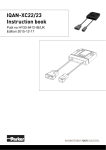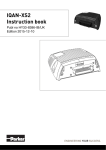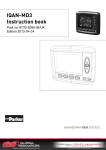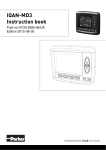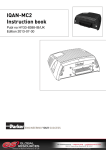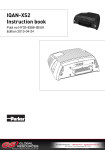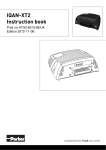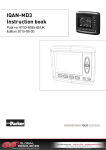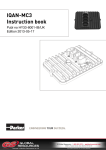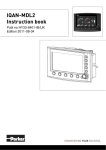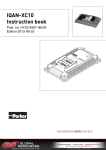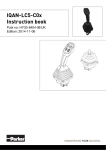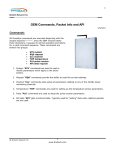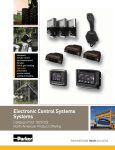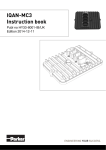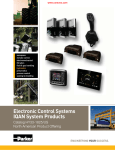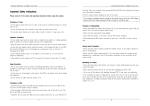Download User Manual - GS Global Resources
Transcript
IQAN-MD4 Instruction book Publ no HY33-8408-IB/UK Edition 2014-08-25 Contents Contents 1 Introduction . . . . . . . . . . . . . . . . . . . . . . . . . . . . . . . . . . . . . . . . . . . . . . . . . . . . 1 Warnings . . . . . . . . . . . . . . . . . . . . . . . . . . . . . . . . . . . . . . . . . . . . . . . . . . . . 1 Overview of relevant documentation . . . . . . . . . . . . . . . . . . . . . . . . . . . . . . . 2 2 Precautions . . . . . . . . . . . . . . . . . . . . . . . . . . . . . . . . . . . . . . . . . . . . . . . . . . . . 3 Read This . . . . . . . . . . . . . . . . . . . . . . . . . . . . . . . . . . . . . . . . . . . . . . . . . . . . 3 Design of control system . . . . . . . . . . . . . . . . . . . . . . . . . . . . . . . . . . . . . 3 Start-up, maintenance, and diagnostics . . . . . . . . . . . . . . . . . . . . . . . . . 4 3 Product description . . . . . . . . . . . . . . . . . . . . . . . . . . . . . . . . . . . . . . . . . . . . . 5 IQAN-MD4 . . . . . . . . . . . . . . . . . . . . . . . . . . . . . . . . . . . . . . . . . . . . . . . . . . . 5 System overview . . . . . . . . . . . . . . . . . . . . . . . . . . . . . . . . . . . . . . . . . . . 5 I/O . . . . . . . . . . . . . . . . . . . . . . . . . . . . . . . . . . . . . . . . . . . . . . . . . . . . . . . . . 6 Voltage inputs . . . . . . . . . . . . . . . . . . . . . . . . . . . . . . . . . . . . . . . . . . . . . 6 Digital inputs . . . . . . . . . . . . . . . . . . . . . . . . . . . . . . . . . . . . . . . . . . . . . . 6 Communication . . . . . . . . . . . . . . . . . . . . . . . . . . . . . . . . . . . . . . . . . . . . . . . 7 CAN related functions . . . . . . . . . . . . . . . . . . . . . . . . . . . . . . . . . . . . . . . 7 Ethernet . . . . . . . . . . . . . . . . . . . . . . . . . . . . . . . . . . . . . . . . . . . . . . . . . . 7 HMI (human machine interface) . . . . . . . . . . . . . . . . . . . . . . . . . . . . . . . . . . . 7 4 Safety . . . . . . . . . . . . . . . . . . . . . . . . . . . . . . . . . . . . . . . . . . . . . . . . . . . . . . . . . 8 Internal diagnostics . . . . . . . . . . . . . . . . . . . . . . . . . . . . . . . . . . . . . . . . . . . . 8 CAN-bus interruption . . . . . . . . . . . . . . . . . . . . . . . . . . . . . . . . . . . . . . . . . . . 8 Current check . . . . . . . . . . . . . . . . . . . . . . . . . . . . . . . . . . . . . . . . . . . . . . . . . 8 Emergency stop . . . . . . . . . . . . . . . . . . . . . . . . . . . . . . . . . . . . . . . . . . . . . . . 8 5 Mounting . . . . . . . . . . . . . . . . . . . . . . . . . . . . . . . . . . . . . . . . . . . . . . . . . . . . . . 9 Mounting the module . . . . . . . . . . . . . . . . . . . . . . . . . . . . . . . . . . . . . . . . . . . 9 Dashboard or panel assembly . . . . . . . . . . . . . . . . . . . . . . . . . . . . . . . . 9 Ball or tilt/swivel mount . . . . . . . . . . . . . . . . . . . . . . . . . . . . . . . . . . . . . . 9 Mounting considerations . . . . . . . . . . . . . . . . . . . . . . . . . . . . . . . . . . . . 10 6 Installation . . . . . . . . . . . . . . . . . . . . . . . . . . . . . . . . . . . . . . . . . . . . . . . . . . . . 11 Connector C1 and C2 . . . . . . . . . . . . . . . . . . . . . . . . . . . . . . . . . . . . . . . . . . 11 Connector C1 pin assignments . . . . . . . . . . . . . . . . . . . . . . . . . . . . . . . 12 Connector C2 pin assignments . . . . . . . . . . . . . . . . . . . . . . . . . . . . . . . 12 Connector C3 and C4 . . . . . . . . . . . . . . . . . . . . . . . . . . . . . . . . . . . . . . 13 Supply voltage . . . . . . . . . . . . . . . . . . . . . . . . . . . . . . . . . . . . . . . . . . . . . . . 14 Emergency stop . . . . . . . . . . . . . . . . . . . . . . . . . . . . . . . . . . . . . . . . . . 14 Connecting of Supply Voltage . . . . . . . . . . . . . . . . . . . . . . . . . . . . . . . . 14 Polarity reversal . . . . . . . . . . . . . . . . . . . . . . . . . . . . . . . . . . . . . . . . . . 14 Addressing . . . . . . . . . . . . . . . . . . . . . . . . . . . . . . . . . . . . . . . . . . . . . . . . . . 15 IQAN-MD4 use of an ID-Tag . . . . . . . . . . . . . . . . . . . . . . . . . . . . . . . . . 15 Identification of an IQAN-MD4 by address . . . . . . . . . . . . . . . . . . . . . . 15 Diagnostic interfaces . . . . . . . . . . . . . . . . . . . . . . . . . . . . . . . . . . . . . . . . . . 16 CAN diagnostics connection . . . . . . . . . . . . . . . . . . . . . . . . . . . . . . . . . 16 Ethernet diagnostics communication . . . . . . . . . . . . . . . . . . . . . . . . . . 17 Video input . . . . . . . . . . . . . . . . . . . . . . . . . . . . . . . . . . . . . . . . . . . . . . . . . . 17 Analog Cameras . . . . . . . . . . . . . . . . . . . . . . . . . . . . . . . . . . . . . . . . . . 18 Reference voltage, VREF . . . . . . . . . . . . . . . . . . . . . . . . . . . . . . . . . . . . . . . 19 Voltage inputs . . . . . . . . . . . . . . . . . . . . . . . . . . . . . . . . . . . . . . . . . . . . . . . 20 Connecting sensors to the voltage inputs . . . . . . . . . . . . . . . . . . . . . . . 20 Connecting a 2-wire temperature sensor to voltage in . . . . . . . . . . . . . 21 Instruction book, IQAN-MD4 ii Contents Connecting switches to the voltage inputs using VREF . . . . . . . . . . . . 21 Connecting switches to the voltage inputs using +BAT . . . . . . . . . . . . 22 Directional pulse count input . . . . . . . . . . . . . . . . . . . . . . . . . . . . . . . . . . . . 23 Connecting a directional pulse count channel (DPCNT) . . . . . . . . . . . . 23 Low-side digital outputs . . . . . . . . . . . . . . . . . . . . . . . . . . . . . . . . . . . . . . . . 24 7 Start-up . . . . . . . . . . . . . . . . . . . . . . . . . . . . . . . . . . . . . . . . . . . . . . . . . . . . . . . 25 Start-up procedures . . . . . . . . . . . . . . . . . . . . . . . . . . . . . . . . . . . . . . . . . . . 25 Starting the control system . . . . . . . . . . . . . . . . . . . . . . . . . . . . . . . . . . 25 Prepare for system start . . . . . . . . . . . . . . . . . . . . . . . . . . . . . . . . . . . . 25 Start the system . . . . . . . . . . . . . . . . . . . . . . . . . . . . . . . . . . . . . . . . . . 25 Appendix A . . . . . . . . . . . . . . . . . . . . . . . . . . . . . . . . . . . . . . . . . . . . . . . . . . . 26 IQAN-MD4 Technical Overview . . . . . . . . . . . . . . . . . . . . . . . . . . . . . . . . . . 26 Appendix B . . . . . . . . . . . . . . . . . . . . . . . . . . . . . . . . . . . . . . . . . . . . . . . . . . . 30 Error messages and actions . . . . . . . . . . . . . . . . . . . . . . . . . . . . . . . . . . . . . 30 Failure Modes . . . . . . . . . . . . . . . . . . . . . . . . . . . . . . . . . . . . . . . . . . . . . . . . 30 Failure modes for CAN interface . . . . . . . . . . . . . . . . . . . . . . . . . . . . . . 30 Failure modes for VREF . . . . . . . . . . . . . . . . . . . . . . . . . . . . . . . . . . . . 31 Failure modes for VIN . . . . . . . . . . . . . . . . . . . . . . . . . . . . . . . . . . . . . . 31 Failure modes for DIN . . . . . . . . . . . . . . . . . . . . . . . . . . . . . . . . . . . . . . 31 Appendix C . . . . . . . . . . . . . . . . . . . . . . . . . . . . . . . . . . . . . . . . . . . . . . . . . . . 32 Dimensioning of the IQAN-MD4-7 . . . . . . . . . . . . . . . . . . . . . . . . . . . . . . . . 32 Dimensioning of the IQAN-MD4-5 . . . . . . . . . . . . . . . . . . . . . . . . . . . . . . . . 33 Instruction book, IQAN-MD4 iii Warnings 1 1 Introduction Introduction These instructions are to be used as a reference tool for the vehicle manufacturer’s design, production, and service personnel. The user of these instructions should have basic knowledge in the handling of electronic equipment. Warnings Sections marked with a symbol in the left margin, must be read and understood by everyone using the system, carrying out service work, or making changes to hardware and software. The different symbols used in this manual are defined below. WARNING Sections labeled WARNING with a caution symbol in the left margin, indicate that a hazardous situation exists. We use warnings, marked with the warning symbol, in two ways. • As a strong recommendation about work practices when using the product in the machine (e.g. routines when updating an application). This use is common to the term 'hazardous situation', that a person is exposed to a hazard. • As a way of pointing out important information for the machine designer that in some way relates to safety. This includes the design of the physical machine, and also the application program being developed for the control system. Not all document sections that contain information about safety are marked with a warning symbol (there would be warnings everywhere). Failure to comply with the recommendations can cause unintentional, and unexpected behavior of the control system. This can potentially cause death, serious injury or property damage. N OTICE Sections labeled NOTICE with a notice symbol in the left margin, indicate there is important information about the product. Ignoring this could result in less than optimal performance, or damage to the product. Contact the manufacturer if there is anything you are not sure about or if you have any questions regarding the product and its handling or maintenance. The term "manufacturer" refers to Parker Hannifin Corporation. 1 Instruction book, IQAN Overview of relevant documentation 1 Introduction Overview of relevant documentation The following publications are relevant for users of this product. The main documentation contains information that is not found elsewhere. The additional documentation contains product information in a compact format, for details on the information found in those documents, consult this manual. Main Documentation Compact Documentation IQANdesign/ IQANrun User Manuals IQAN module Instruction Book HY33-8nnn-IB IQAN module Catalogue Datasheet HY33-8nnn Mounting and Maintenance Instruction Book HY33-8327-IB IQAN module Installation Sheet HY33-8nnn-IS IQAN module Electrical Schematic HY33-8nnn-ES The IQAN module documentation system. 2 Instruction book, IQAN Read This 2 2 Precautions Precautions Work on the hydraulics control electronics may only be carried out by trained personnel who are well-acquainted with the control system, the machine and its safety regulations. WARNING Make sure that you have sufficient knowledge before designing, modifiying or servicing the control system. Read the relevant sections of this document before conducting any work on the control system. WARNING This product is not field repairable. N OTICE As much as possible of the welding work on the chassis should be done before the installation of the system. If welding has to be done afterwards, the electrical connections on the system must be disconnected from other equipment. The negative cable must always be disconnected from the battery before disconnecting the positive cable. The ground wire of the welder shall be positioned as close as possible to the place of the welding. The cables on the welding unit shall never be placed near the electrical wires of the control system. Read This Design of control system WARNING Risk of injury may be introduced by design of control system! This product is designed to control hydraulic outputs. The control application must be designed using basic safety principles so that unintentional movement is avoided. The machine must be equipped with an emergency stop that stops all movement. Please refer to section "Supply voltage". Before you start Read this document. Read the IQANdesign software user manual section on 'application safety'. 3 Instruction book, IQAN Read This 2 Precautions Start-up, maintenance, and diagnostics For all personnel carrying out installation, commissioning, maintenance or troubleshooting. WARNING Work on the hydraulics control electronics may only be carried out by trained personnel who are well-acquainted with the control system, the machine and its safety regulations. Before you start, Read section "Start-up". Additional information for service Mounting and maintenance instruction book. Additional information for diagnosing the system Read section "System diagnostics", and see "Appendix B", in this document. Use the IQANrun software user manual as a reference. 4 Instruction book, IQAN IQAN-MD4 3 3 Product description Product description IQAN-MD4 The IQAN-MD4 is a family of combined display and bus master modules capable of running applications created by IQANdesign software. Built on a 32-bit platform the units have large computational power and is capable of controlling large applications. The IQAN-MD4 module. System overview The master module, IQAN-MD4, is the central unit in the system, or in the case of a multi-master system, one of the central units. IQAN-MD4 has four CAN buses and two ethernet ports. The CAN buses support ICP and are able to control IQAN expansion units. SAE J1939 and Generic CAN protocols are also supported on the CAN buses and gives the possibility to interface to 3rd party units. A touch screen in combination with a graphical display makes system feedback with user interaction possible. The display in the module has very high optical performance across a wide operating temperature range and over a wide range of ambient light. IQAN-MD4 has voltage and digital inputs that are designed to be flexibly configured using IQANdesign software. The unit also has four low side digital outputs. All I/O are EMI filtered and protected against short circuit to -BAT and +BAT. Levers IQAN-MD4 Expansion units A typical IQAN-MD4 System 5 Instruction book, IQAN-MD4 I/O 3 Product description I/O +BAT CAN-H -BAT CAN-L +RTC CAN-H +VREF MD4 CAN-L CAN-H CAN-L ETHERNET PORT 0 CAN-H CAN-L PORT 1 Voltage inputs The IQAN-MD4 module has two (2) voltage inputs VIN-A andVIN-B for connection of 0-5 Vdc signals. These inputs can be configured as digital inputs for reading switches. Voltage inputs and digital inputs share positions, see below. (2) Voltage inputs VIN-A and VIN-B or (2) Digital inputs DIN-I and DIN-J Digital inputs The IQAN-MD4 module has eight (8) digital inputs DIN-A thru DIN-H. DIN-A thru DIN-D are multi purpose and can be configured as low-side on/off outputs. DIN-G and DIN-H are multi purpose and can be configured as a directional pulse count input. see below. (8) Digital inputs DIN-A thru DIN-H or (4) Digital inputs DIN-E thru DIN-H, (4) Digital outputs DOUT-A thru DOUT-D or (6) Digital inputs DIN-A thru DIN-F, (1) Directional pulse count input DPCNT 6 Instruction book, IQAN-MD4 Communication 3 Product description Communication The communication interfaces are used for uploading/downloading applications, connecting to expansion modules, connecting to cameras or diagnostics. CAN related functions The IQAN-MD4 uses a CAN-bus (CAN = Controller Area Network) to communicate with IQAN expansion modules and other systems. The CAN-bus is a robust communication protocol that is widely used and well proven within the automotive industry. The unit has four (4) CAN buses, CAN-A thru CAN-D. The buses may be configured using IQAN software to be ICP (ICP = IQAN CAN Protocol), SAE J1939 or Generic user defined CAN protocol (e.g. CANopen). Any of the CAN buses may be used for communication and diagnostics. A compatible CAN communication card is required to be installed in your PC to use this feature. Ethernet The MD4 has two Ethernet communication ports, A (C3) and B (C4). Port A is used for uploading/downloading applications and diagnostics and is designated for computer communication. see Ethernet diagnostics communication for more information. Port B is used for in-vehicle network over Ethernet, for example communicating with cameras. see Video input for more information on how to use cameras. HMI (human machine interface) TBD 7 Instruction book, IQAN-MD4 Internal diagnostics 4 4 Safety Safety Internal diagnostics The module performs a number of self-checks that improve safety. Checks include monitoring of voltage supplies, checksums on memory and a watchdog that monitors software execution. The module is using a real time operating system which supervises software execution. If a critical error is detected, the module is stopped, with CAN-bus and outputs off. CAN-bus interruption The IQAN modules communicate on a CAN-bus. Both the master module and expansion modules check for any interruptions in CAN-bus communication. If an error occurs the master will use zero or an application defined error value for the module inputs, and the module outputs will be off. The error will be presented on the master/display module, if there is one, and with a related blink code on the IQAN module status LEDs. Current check For the proportional outputs when used in current mode, a current check is performed. If an error is detected, this will be indicated on the master module, and the output will shut off. The module can detect open-circuit, short-circuit to +BAT/-BAT or short-circuit to other proportional output and return pins. Emergency stop WARNING Risk of injury! The emergency stop must disconnect the power supply to the module; do not connect the emergency stop as a signal input only. The emergency stop must be installed so that the risk of reverse feed of the module is avoided, see section "Supply voltage". 8 Instruction book, IQAN Mounting the module 5 5 Mounting Mounting Mounting the module The IQAN module should be mounted according to the following instructions: Dashboard or panel assembly When installing in a dash or panel the recommended panel thickness is 1.0 - 3.5 mm. Use M4 screws to attach the supplied steel clips.. Panel mounting the IQAN-MD4 Ball or tilt/swivel mount The option to use ball mounting or tilt swivel mounting for display position flexibility is made possible by using Parker’s aluminum bracket. Use M4 screws to attach the aluminum bracket to the display The bracket will accept Southco or RAM™ mounts. Adjustable mounting the IQAN-MD4 N OTICE Select the screw length so that the thread engagement in the unit is 6-8 mm. • Less engagement and the screw may not hold. • More engagement and the housing may be damaged. 9 Instruction book, IQAN-MD4 Mounting the module 5 Mounting Mounting considerations N OTICE IQAN-MD4 shall be positioned in the machine per the following instructions: • The unit is designed for outdoor use. Position the unit in desired location and make sure that it is not exposed to mechanical damage. • The connectors on the reverse side of the unit should be accessible. • Position the unit so there is no risk that the cabling can be folded, crushed, worn or damaged in any way. • Leave sufficient room behind the unit to insert connectors. Less than 75 mm clearance will stress the cabling and distort the seals in the connectors. This can cause the environmental specification not to be met. 48 5,5 75 mm Distance behind the unit. N OTICE • Position the unit so there is no risk to be exposed to external heat, e.g. from the engine or heater. • The best readability will be achieved by positioning the front face of the unit directly towards the operator. • Extended periods of exposure to direct sunlight can cause an internal temperature exceeding 90°C which may cause permanent degradation of the LCD display. N OTICE All of the connectors, C1 to C4, must be properly installed in the unit. • If you leave a connector unplugged, the unit will not be sealed. • If unused wire positions in a connector are not closed with the recommended plugs, the unit will not be sealed. 10 Instruction book, IQAN-MD4 Connector C1 and C2 6 6 Installation Installation Connector C1 and C2 Connector kit Parker 20073081 C1 (DTM12 key A) Housing C1 Deutsch no. DTM06-12SA Pin type Deutsch no. 1062-20-0222 Wedge type Deutsch no. WM12S Sealing plug Deutsch no. 0413-204-2005 1 2 3 4 12 11 10 9 5 8 6 7 C2 (DTM12 key B) Housing C2 Deutsch no. DTM06-12SB Pin type Deutsch no. 1062-20-0222 Wedge type Deutsch no. WM12S Sealing plug Deutsch no. 0413-204-2005 Recommended cable 0.75-1 mm² (18 AWG) 1 2 3 12 11 10 4 9 5 8 6 7 N OTICE No pin may be "double crimped". That means only one wire may be attached to any given pin. Failure to follow this instruction will cause the module to not meet the environmental specification. Make "Y" connections or splices using weatherproof methods external to the IQANMD4 connectors. +BAT CAN-H -BAT CAN-L +RTC CAN-H +VREF MD4 CAN-L CAN-H CAN-L ETHERNET PORT 0 CAN-H CAN-L PORT 1 11 Instruction book, IQAN-MD4 Connector C1 and C2 6 Installation Connector C1 pin assignments Pin No. Symbol Function C1:1 -BAT Power supply C1:2 CANL-A CAN low voltage bus line C1:3 CANL-B CAN low voltage bus line C1:4 CANL-C CAN low voltage bus line C1:5 CANL-D CAN low voltage bus line C1:6 ADDR-L Low side to address tag. Return (0V) C1:7 ADDR-H High side to address tag. Sourcing +5V C1:8 CANH-D CAN high voltage bus line C1:9 CANH-C CAN high voltage bus line C1:10 CANH-B CAN high voltage bus line C1:11 CANH-A CAN high voltage bus line C1:12 +BAT Power supply Connector C2 pin assignments Pin No. Function Alt. Function C2:1 VIN-A DIN-I C2:2 VIN-B DIN-J C2:3 DIN-A DOUT-A C2:4 DIN-B DOUT-B C2:5 DIN-C DOUT-C C2:6 DIN-D DOUT-D C2:7 DIN-E C2:8 DIN-F C2:9 DIN-G +DPCNT-A C2:10 DIN-H -DPCNT-A C2:11 +VREF* C2:12 +RTC *Use -BAT on C1 as -VREF. Make the connection as close to the C1 connector as possible to minimise voltage fluctuation. 12 Instruction book, IQAN-MD4 Connector C1 and C2 6 Installation Connector C3 and C4 Connector kit Parker N/A Recommended cable 20077780 M12 4pin D-code Industrial Ethernet Connector C3 and C4 pin assignments Pin No. Symbol Function C3/4:1 TD+ Transmit data + C3/4:2 RD+ Receive data + C3/4:3 TD- Transmit data - C3/4:4 RD- Receive data - C3/4:Shield Shield Shield 13 Instruction book, IQAN-MD4 Supply voltage Supply voltage Before any installation of the IQAN system can take place, make sure the ignition lock is turned off and the battery is disconnected. Emergency stop Make sure an Emergency Stop disconnecting the power supply, is easily accessible at any time. The figure below shows how to connect the emergency stop. Connecting of Supply Voltage The supply voltage, should be within the operating interval, see Appendix A. Connect the supply voltage to +BAT and -BAT. Protect the module by using a fuse. For recommended fuse level, see Appendix A. RTC supply IQAN master modules have a clock that is used for date/time stamping when logging data. The real time clock, +RTC, requires a separate positive power connection. Connect the supply voltage to +RTC through a 1.5K ohm resistor. The resistor should be as close to the battery as possible for safety. IQAN expansion modules do not have +RTC. WARNING Risk of injury! To reduce the risk for uncontrolled supply of an IQAN master module, i.e., a short circuit between the +RTC cable and +BAT, a resistor must be connected between the battery and the +RTC input. This is important as this line is not controlled by an emergency stop. The resistor should be placed close to the battery, as the ’protected’ part is the cable between the resistor and the unit. This will prevent the +RTC wire from powering up the unit if shorted to +BAT. IQAN module Emergency Stop Fuse * +BAT +RTC (if master unit) 1.5 k -BAT + - * Symbol for disconnecting switch for battery, ignition lock and other fuses. Connecting the emergency stop and voltage supply. N OTICE Do not use the chassis as the negative terminal. Polarity reversal The module is protected against power supply polarity reversal and over-voltage, provided an external fuse is being used. If this fuse is not used, polarity reversal can damage the unit. 14 Instruction book, IQAN Addressing Addressing IQAN-MD4 use of an ID-Tag In IQANdesign 3.0 and higher software, more than one IQAN master module can be used together in a multi-master system. The master modules are each given a unique address by using an ID-Tag. The value of the ID-Tag identifies the master and will enable a single project application to be loaded into more than one master module over the CAN bus. The functionality needed for each master is loaded based on the ID-tag address. Identification of an IQAN-MD4 by address For normal operation of an IQAN-MD4 in a single master system, the ID-Tag is still used. When no ID-Tag is installed, the MD4 will start in safe mode. The connection of an ID-Tag between ADDR-H and ADDR-L will assign an address to the IQAN-MD4 master module. The desired functionality based on address is built into the project file using IQANdesign software. For more information, please refer to the IQANdesign user manual. It is the combination of address and module type that gives each master module a unique identification. IQAN-MD4 ADDR-H ADDR-L ID-Tag Connecting of ID-Tag. N OTICE When no ID-Tag is installed, the MD4 will start in safe mode. 15 Instruction book, IQAN-MD4 Diagnostic interfaces Diagnostic interfaces IQAN software includes many tools for tuning, measuring, accessing logs and otherwise checking the performance or troubleshooting your control system. To use the diagnostic tools with an IQAN master module you may choose between different ways to connect to the unit. CAN diagnostics connection One of the CAN buses of the IQAN master module may be dedicated for diagnostics. Reserving a bus for diagnostics ensures that signals are not interrupted by other bus traffic. A high-speed CAN interface is needed to use this feature. Contact Parker for information about supported CAN interfaces. A termination resistor is usually required at the CAN interface on the PC. Parker part number 5030082 or 5030182, or an equivalent 120 ohm resistor may be used. A flying lead cable may be connected to the IQAN master to provide a connector interface. The connection from IQAN master module to diagnostic CAN interface can then be made quite easily. It is recommended that the connector be a sealed, automotive type. When not being used this connector should be protected from the environment with a cover or mating blank plug. The recommended wiring to the IQAN master module connector is shown below. IQAN master CAN-X-H Customer provided connector 120 ohm CAN-X-L Connecting for CAN communication. 16 Instruction book, IQAN Video input Ethernet diagnostics communication The "A" (C3) Ethernet port is used for diagnostic communication or uploading and downloading project files using IQANdesign/IQANrun. On port A, the IP address is automatically assigned using DHCP. It is recommended to use an environmentally sealed panel mounted RJ45 connector for easy access. Parker part number 20077785. Video input The IQAN MD4 master modules are capable of showing video inputs from an external source. When connecting a video source to the system it is the ethernet port "B" (C4) that is used. The C4 port is dedicated for the in-vehicle network (i.e video input, master-to-master communication). On port B the MD4 uses static IP addresses, so all video sources must have a valid and unique IP address set beforehand in order to be used, see IQANdesign manual for valid IP address range. For information on how to set the camera IP address see the camera instruction book. N OTICE The IQAN-MD4 use motion JPEG (MJPEG) as video format when communicating with cameras. A single camera may be connected directly to the unit. The camera must be powered, there is no POE (power over ethernet) available. IQAN-MD4 IP camera Ethernet cable Connecting a camera to the MD4 display. Using a ethernet switch it is possible to have multiple cameras connected to one MD4 or to have one camera connected to multiple MD4 displays. IP camera 1 IQAN-MD4 IP camera 2 Ethernet switch Connecting multiple cameras to one MD4. 17 Instruction book, IQAN-MD4 Video input Analog Cameras It is also possible to connect an analog camera by routing the video feed through a video server with ethernet connection. In this case, it is the video server that needs to have the correct IP address set. 18 Instruction book, IQAN-MD4 Reference voltage, VREF Reference voltage, VREF The IQAN module is internally equipped with a voltage regulator to generate the reference voltage VREF. The standard reference voltage will feed different kinds of sensors and potentiometers. On the IQAN-MD4 there is no -VREF pin, instead the -BAT is used as -VREF. To get the best result, connect as close to the connector as possible to minimise voltage fluctuations. In connection examples that follow, -VREF will refer to the -BAT pin. IQAN module +VREF -BAT VREF positions. N OTICE Maximum load for the VREF is different according to 12/24 Vdc power supply, see "Appendix A". 19 Instruction book, IQAN-MD4 Voltage inputs Voltage inputs Connecting sensors to the voltage inputs The sensor signal range must be 0-5 Vdc. To detect signal errors such as short circuits or interruptions the active signal range be within 0.5-4.5 Vdc. [V] 5 Error detection range Active signal range Error detection range 0 t Active signal range. The current consumption related to the voltage input is negligible. The positive terminal of the sensor is connected to the +VREF position and the corresponding negative terminal to the -VREF position. The sensor signal is connected to appropriate VIN position. EXAMPLE Connect the positive and negative terminals of the position sensor to +VREF, and -VREF, respectively. Then connect the sensor signal to VIN-X. IQAN module +VREF VIN-X -VREF Position Sensor Connecting VREF and sensor signal VIN-X. N OTICE The negative terminal of the sensor must not be connected to the chassis. Maximum load for VREF position: see Appendix A. Connecting other 3 wire sensors The same type of connection shown for potentiometers is used for other 3 wire sensors supplied with power from the regulated 5VDC supply, VREF. This includes active temperature sensor IQAN-ST, pressure sensor IQAN-SP and Hall-effect levers IQANLST or IQAN-LSL. 20 Instruction book, IQAN Voltage inputs Connecting a 2-wire temperature sensor to voltage in When you connect a PTC (positive temperature coefficient) temperature sensor you may need to use a pull up resistor on the input signal. Please check the technical data for your specific temperature sensor. EXAMPLE Connect the negative terminal of the temperature sensor to -VREF, and the signal to VIN-X. The pull up resistor will be connected between VIN-X, and +VREF. IQAN module +VREF pull up VIN-X -VREF Sensor Connecting -VREF and temperature sensor signal VIN-X. The pull up resistor value for a R25=2000 PTC sensor is 4,7 K Connecting switches to the voltage inputs using VREF Switches could be connected to the voltage inputs, to create a digital on/off signal. The switches should be connected to +VREF and VIN/DIN respectively for 5V signal. The current consumption for the input is negligible. EXAMPLE Connect the positive and negative terminals of the switch to +VREF, and VIN-X, respectively. IQAN module +VREF VIN/DIN-X switch Connecting a switch to VIN-X and VREF. N OTICE Maximum load for VREF position, see "Appendix A". 21 Instruction book, IQAN Voltage inputs Connecting switches to the voltage inputs using +BAT It is recommended to connect system voltage +BAT to the input through a switch in order to reserve 5Vdc VREF for sensors and potentiometers. EXAMPLE Connect the positive and negative terminals of the switch to supply or the unit’s +BAT, and DIN-X, respectively. +BAT IQAN module DIN-X switch Connecting a switch to DIN-X and +BAT. 22 Instruction book, IQAN Directional pulse count input Directional pulse count input Connecting a directional pulse count channel (DPCNT) The DPCNT is a physical analog input. The directional pulse count input channel is used to count pulses. It is bi-directional, which means it can add and subtract pulses. The DPCNT is primarily designed for input from an encoder wheel. For maximum frequency, see Appendix A. Simple directional pulse count sensor The positive terminal of the directional pulse count sensor is connected to the +VREF and the negative terminal to the -VREF respectively. The sensor signals are connected to the DPCNT+ and DPCNT- positions.. EXAMPLE Connect the positive and negative terminals of the frequency sensor to +VREF and -VREF, respectively. Then connect the sensor signals to DPCNT+ and DPCNT-. IQAN module +VREF DPCNT-X+ DPCNT-X-VREF Directional pulse count sensor Connecting of directional frequency sensor to DFIN+ and DFIN-. N OTICE The negative terminal of the sensor must not be connected to the chassis. Maximum load for VREF position, see Appendix A. 23 Instruction book, IQAN Low-side digital outputs Low-side digital outputs The low-side digital outputs are designed to drive small loads, e.g. lamps and buzzers. Low-side digital outputs work by grounding a signal through the module. See Appendix A for maximum loads per output. EXAMPLE Connect the lamp to the low-side digital outputs using a DOUT(LS) position, and the +BAT, as supply. +BAT IQAN module load DOUT(LS)-X Connecting a switch to DOUT(LS)-X and +BAT. 24 Instruction book, IQAN Start-up procedures 7 7 Start-up Start-up Start-up procedures This chapter contains instructions for action to be taken in connection with the initial start. WARNING Risk of injury! If the control system is not fitted properly, the machine could move uncontrollably. The machine’s engine shall not be started before the control system is completely fitted and its signals are verified. Starting the control system Start the control system as follows: • Prior to start, all modules and cables are to be fitted correctly. • Check fuses, i.e. make sure that the supply voltage to the modules is equipped with the correct fuse. • Make sure that connections for supply voltage and return lines are correct in the cable’s conductor joint. • Make sure an emergency stop is installed. The emergency stop should disconnect the supply voltage to all modules. Alternatively, the emergency stop may also shut off the diesel engine or a dump valve, and with that, depressurize the hydraulic system. Prepare for system start WARNING Make sure no one is in dangerous proximity to the vehicle to avoid injuries when it starts. Prepare for the initial system start as follows: • • • • The engine for the hydraulic system’s pump shall be in off position. Make sure that all connectors are properly connected. Turn on the control system. Make sure that voltage is being supplied to all modules; the power/status diode shall be illuminated on all modules. Also, make sure that the master is in contact with all modules by reading the master’s display. • Make sure the emergency stop is functioning properly. Start the system Start the system as follows: • Start the engine for the hydraulic system’s pump, assuming that the above mentioned inspections have been carried out and shown correct values. Calibrate and adjust input and output signals according to the instructions related to the master menu system and check each and every output function carefully. 25 Instruction book, IQAN IQAN-MD4 Technical Overview Appendix A Appendix A IQAN-MD4 Technical Overview Absolute Maximum Ratingsa Ambient temperature -30 to 70 °C Storage temperature -40 to 85 °C Voltage supply on +BAT 6.5 to 36 V (Reverse polarity protected with up to 20A fuse) Voltage on any pin with respect to -BAT 36 V a.The “Absolute Maximum Ratings” table lists the maximum limits to which the device can be subjected without damage. This doesn´t imply that the device will function at these extreme conditions, only that, when these conditions are removed and the device operated within the “Recommended Operating Conditions”, it will still be functional and its useful life won’t have been shortened. Environmental ratings Climate environment Enclosure, water & dust protection Salt mist Damp heat cyclic Damp heat steady state Heat, operation Cold Change of temperature IEC 60529:2001, IP65; (front and back) IEC 60068-2-52:1996 Kb, 72 h IEC 60068-2-30:2005 Db, +55°C, 95% RH, 6 cycles IEC 60068-2-78:2001 Cab, +40°C, 93% RH, 21 days IEC 60068-2-2:2007 Bb, +70°C, 72 hours IEC 60068-2-1:1993 Ab, -30°C, 16 hours IEC 60068-2-14:1984 Nb, - 30°C to +55°C, 10 x 8 hours Mechanical environment Random vibration Bump IEC 60068-2-64: 2008 Fh, 15 - 1000 Hz, 7.1 Grms, 3 x 10 h IEC 60068-2-27:2008 Ea, 40 g, 6 ms, 1000 * 6 dir EMC Radiated emission Conducted emission Conducted emission, transients Conducted susceptibility Radiated susceptibility Conducted transients susceptibility ESD, Operation ESD, Handling ISO 13766:2010/ISO 14982:2009 EN 55025:2008, 0.15-108 MHz, Class 2 ISO 7637-2:2004, 12/24 V, Level 2 ISO 11452-4:2005, 1 - 200 MHz, 1 kHz, 80% AM, 150 mA ISO 11452-2:2004, 200-2000 MHz, 1kHz, 80% AM, 100 V/m ISO 11452-2:2004, 800-2000 MHz, PM 577 µs / 4.6 ms, 60 V/m ISO 7637-2:2004, Pulse 1, 2a, 2b, 3a, 3b, 4, Level 3; Pulse 5, Level 1 ISO 7637-3:2007, Level 3 ISO 10605:2008, 8 kV (contact), 25 kV (air) ISO 10605:2008, 8 kV (contact) 26 Instruction book, IQAN-MD4 IQAN-MD4 Technical Overview Appendix A System TA = -30 to +70 °C, unless otherwise specified Weight MD4-7 MD4-5 930g 670g Ambient temperature, TROC -30 to 70 °C Voltage supply on +BAT, VBAT 9 to 32 V Recommended fuse 3A to 5A, fast Current supply VBAT = 14V VBAT = 28V 600 mA 300 mA Current supply RTC VBAT = 14V VBAT = 28V RTC backup time 1.7 mA 3.7 mA 4 hours (VBAT=0, VRTC=0) Start-up time In-vehicle system running HMI running 2 s (typical) 5 s (typical) System cycle time, TSC 25 ms to 100 ms Embedded Flash memory 2 GB Embedded RAM memory 256 MB Data log memory 64 MB LCD - MD4-7 (18 cm) Resolution 800 x 480 dots Number of Colors 262 K Active area 152 x 91 mm Brightness 800 cd/m2 (reduced to 50% if VBAT<14 V) Viewing angle 85 degree all directions Contrast Ratio 600 Touch sensor PCAP LCD - MD4-5 (14 cm) Resolution 640 x 480 dots Number of Colors 262 K Active area 115 x 86 mm Brightness 800 cd/m2 (reduced to 50% if VBAT<14 V) Viewing angle 80 degree all directions Contrast Ratio 400 Touch sensor PCAP (depends on variant) 27 Instruction book, IQAN-MD4 IQAN-MD4 Technical Overview Appendix A Sensor supply - VREF Number of VREF 1 Output voltage 5 V ±150 mV, -30 to 70 °C Output voltage temperature drift 0.50 mV/°C Maximum load current 50 mA Protection over load, SCB, SCG Diagnostics over/under voltage Under/over voltage threshold ±150 mV from nominal value Signal input - VIN Number of VIN 2 (configuration may reduce number) VIN full scale 5000 mV ±100 mV VIN resolution 12 bits = 1.22 mV Input impedance 36 kohm in parallel with 10 nF Accuracy ± (1% + 25mV) Sample rate Same as system cycle time TSC Maximum continuous voltage 32V Protection SCB, SCG Diagnostics defined in application Signal input - DIN Number of DIN 10 (configuration may reduce number) Logic levels low high hysteresis <0.5 V >3 V >150 mV Input impedance 6.8 kohm Sample rate Same as system cycle time TSC Maximum continuous voltage 32 V Diagnostics defined in application Signal input - DPCNT Number of DPCNT 1 (configuration may reduce number) Frequency range 0 to 500 Hz, 50/50 signal Minimum pulse width 1 ms Logic levels low high hysteresis <0.5 V >3 V >150 mV Input impedance 6.8 kohm Maximum continuous voltage 32 V Diagnostics defined in application 28 Instruction book, IQAN-MD4 IQAN-MD4 Technical Overview Appendix A Power driver - DOUT Number of DOUT low-side 4 (configuration may reduce number) Maximum load Single channel All channels 300 mA 850 mA Minimum load 2 mA Leakage current in OFF state <200 µA Protection over load, SCB, SCG Diagnostics Operational ON Operational OFF over load open load CAN Number of CAN buses 4 (depends on variant) CAN specification 2.0A and 2.0B CAN bus speed 125 kbit to 500 kbit Protection SCB, SCG Ethernet Number of Ethernet ports 2 (depends on variant) port A dedicated for PC interface Network interface 100 Base-TX, 10 Base-T, Auto-MDIX (auto crossover) Network protocol Port A Port B TCP/IP, UDP Dynamic IP (DHCP/link-local auto-IP) Static IP defined by module type and address tag Network IP configuration Zero configuration Communication rates 10/100 Mbps, auto-negotiated Streaming video Video format Video resolution Port B only Motion JPEG (MJPEG) limited by screen resolution 29 Instruction book, IQAN-MD4 Error messages and actions Appendix B Appendix B Error messages and actions If a fault is detected, a message will be presented on the display. WARNING An error message could indicate that a hazardous situation exists. If precautions are not taken, this could result in death, serious injury or major property damage. Failure Modes The following tables contain information about the different possible failures that could occur for each module subsystem. In most cases when an error is detected, a message will be presented on the master display. In some cases, the master will turn off or at least shut down the outputs, to increase safety. Failure modes for CAN interface Failure mode Effect 1 CAN-H to -BAT No CAN communication. All output turned off. 2 CAN-L to -BAT No CAN communication. All output turned off. 3 CAN-H to +BAT No CAN communication. All output turned off. 4 CAN-L to +BAT No CAN communication. All output turned off. 5 CAN-L open circuit No CAN communication. All output turned off. 6 CAN-H open circuit No CAN communication. All output turned off. 7 CAN-L to CAN-H No CAN communication. All output turned off. 8 CAN-termination failure, termination on No effect 9 CAN-termination failure, termination off Dependent on CAN size and number of CAN nodes. 30 Instruction book, IQAN-MD4 Failure Modes Appendix B Failure modes for VREF Failure mode Effect 1 +VREF Open VIN out of range, will create a VIN error => VIN=Predefined error value. 2 -VREF Open VIN out of range, will create a VIN error => VIN=Predefined error value. 3 +VREF Short-circuit to -VREF VREF error => VIN out of range, will create a VIN error => VIN=Predefined error value. 4 +VREF Short-circuited to +BAT VREF error => VIN out of range, will create a VIN error => VIN=Predefined error value. 5 +VREF Short-circuited to -BAT VREF error => VIN out of range, will create a VIN error => VIN=Predefined error value. 6 -VREF Short-circuited to +BAT External fuse (if <7.5A) on +BAT blows. 7 -VREF Short-circuited to -BAT Not detected. Failure modes for VIN Failure mode 1 VIN Open Effect VIN out of range, will create a VIN error => VIN=Predefined error value1 2 VIN Short-circuited to +BAT VIN out of range, will create a VIN error => VIN=Predefined error value1 3 VIN Short-circuited to -BAT VIN out of range, will create a VIN error => VIN=Predefined error value1 1. Measure is controlled by CAN master and application as a result from the CAN error message. Turning outputs off is controlled by CAN master unit and therefore delayed maximum 2 bus cycles. Failure modes for DIN Failure mode Effect 1 DIN Open No effect on module, not detected 2 DIN Short-circuited to +BAT No effect on module, not detected 3 DIN Short-circuited to -BAT No effect on module, not detected 31 Instruction book, IQAN-MD4 Dimensioning of the IQAN-MD4-7 Appendix C Appendix C 182 160 194 153,4 M4x10 (4x) Dimensioning of the IQAN-MD4-7 18 92,4 133 48 5,5 121 units=mm 183 min. Mounting hole dimensions 121 min 32 Instruction book, IQAN-MD4 Dimensioning of the IQAN-MD4-5 Appendix C M4x10 (4x) 152 130 164 115 Dimensioning of the IQAN-MD4-5 18 86,2 133 48 5,5 121 units=mm 153 min. Mounting hole dimensions 121 min 33 Instruction book, IQAN-MD4 For latest information visit our website www.iqan.com Parker Hannifin Electronic Controls Division SE-435 35 Mölnlycke Sweden Tel +46 31 750 44 00 Fax +46 31 750 44 21 www.parker.com/ecd Information in this instructionbook is subject to change without notice Parker Hannifin Electronic Controls Division 1651 N. Main Street Morton, IL 61550 USA Tel +1 309 266 2200 Fax +1 309 266 6674 Publ no HY33-8408-IB/UK Edition 2014-08-25





































